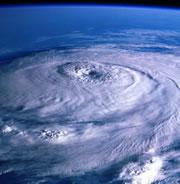 Hurricanes can be discouraged by high wind shear.NASA
Hurricanes can be discouraged by high wind shear.NASAThe increased hurricane activity over the tropical North Atlantic during the past 12 years may have less to do with climate change than is often assumed. The series of stormy seasons experienced since 1995 could just be a return to normal conditions, following a long unusually calm period throughout the 1970s and 1980s, a new study suggests.
As to how climate change will affect hurricanes in the future, this will depend in part on what happens with the wind, the researchers point out — and this is largely unpredictable.
The series of powerful hurricanes that hit the Caribbean and the US Gulf coast over the past few years, including 2005's devastating Katrina and Rita, has fuelled speculation as to whether global warming might be the culprit. Researchers think that rising sea temperatures have a direct impact on the strength of storms, increasing their destructiveness1. But do hurricanes also become more frequent in a warming world?
Reconstructing long-term hurricane trends is notoriously difficult because no reliable instrumental observations exist prior to around 1950. Johan Nyberg, a marine geologist at the Geological Survey of Sweden in Uppsala, and his team have now calculated a unique record of strong Atlantic hurricanes over the past 270 years.
Stormy weather
Hurricane activity, they say, depends both on sea temperature and wind 'shear' — when winds at different altitudes blow in different directions shear is high, and this tends to inhibit storm formation.
To get a handle on wind, they looked at the density of old corals. This depends upon precipitation at the time of growth, which in turn depends largely on trade-wind speed. The trade winds in this part of the world blow in the opposite direction to winds at very high altitudes, so the stronger the trade winds, the stronger the shear.
From their calculated wind-shear data, along with sea-temperature records, they estimated hurricane activity over history. Periods of significantly enhanced hurricane frequency — more than four major storms on average per year — didn't exclusively occur during exceptionally warm climatic conditions, they report in Nature2. Six such high-activity periods appear in the 270-year-long record, all at times when sea and air temperatures were notably lower than today.
ADVERTISEMENT
It's hard to know what the future holds. The ocean is getting warmer, but no one knows what will happen with the winds. "Wind shear is high at the moment," says Nyberg. That could possibly be a result of climate change, he notes, because the atmosphere warms more quickly than the ocean, and that can affect wind. But this may not be the main driver of wind shear. "It's hard to predict the future value. If it were to decrease, hurricane activity could remain high," he says.
What the study can't help determine, however, is how factors such as climate affect the path that storms typically take. It could be that this study missed some storms that happened over the past 270 years because it was looking in the wrong place. More data from corals and marine sediments are needed to reconstruct storm tracks, says Nyberg.
Visit our seasonsbacktonormal.html">newsblog to read and post comments about this story.
